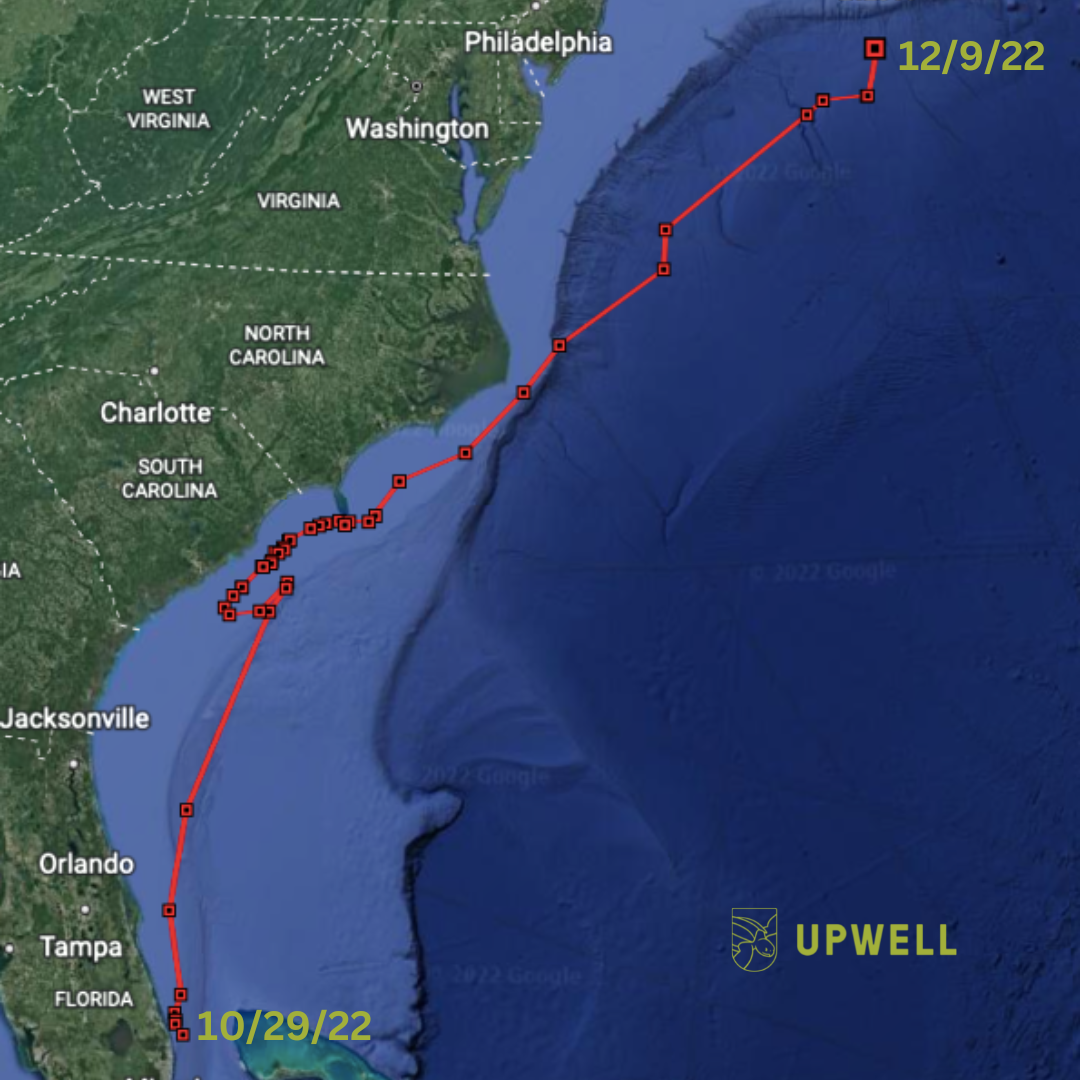Ember, the loggerhead sea turtle, hatched during August of 2021 close to Ocean View Beach Park on Jekyll Island, Georgia. Ember’s nest was excavated early when patrollers from the Georgia Sea Turtle Center(GSTC) noticed it was being invaded by fire ants (Solenopsis invicta). Fire ants excrete a venom that can be deadly to sea turtle hatchlings. Ember was transported to the GSTC and received rehabilitation along with a name which was inspired by the encounter with the ants: Embers are the last to survive a fire as hot coals. The photos below show Ember upon arrival at the GSTC compared to after some months of care.
Photo Credit: Georgia Sea Turtle Center, Jekyll Island Authority.
In October of 2022, Ember was finally ready to be released. Upwell provided a prototype Lotek micro-satellite tag that was affixed to the carapace to collect data about Ember’s oceanic journey. Dr. Terry Norton, Director of Veterinary Services and Wildlife Health, at the GSTC, said, “The GSTC has partnered with Upwell on a couple of projects involving our rehabilitation patients. This partnership allows us to utilize technology and expertise that would normally not be available to us. Learning more about how rehabilitated turtles do after release is extremely important.” The micro-satellite tag weighs less than 5 grams and is designed to shed naturally as Ember grows. On October 28th, The GSTC and the Gumbo Limbo Coastal Stewards Sea Turtle Rehabilitation Team, with assistance from the Boca Raton Police Department Marine Unit, released Ember off the coast of Florida, and the journey began.
Ember’s tag transmits geoposition data which Upwell Oceanographic Researcher, Tony Candela, at Mercator Ocean International analyzes and uses to create maps showing Ember’s movements like the one below.
From the time of Ember’s release in Florida at the end of October to early December, Ember traveled approximately 2178 km (1353 miles) up the US Atlantic Seaboard following the Gulf Stream current. Ember’s speed varied widely during this period. From December 1 - 3, Ember sped across a whopping 277 km (172 miles). Ember traveled at a slower pace from December 3-5, moseying their way over 64 km (40 miles). You may wonder, did Ember get a 200 horsepower engine along with the micro-satellite tag? Nope! Most of Ember’s speed can be attributed to the Gulf Stream Current that acts as a conveyor belt with an average speed of 6.4 km (4 miles) per hour according to NOAA, which means that turtles can travel up to 154 km (96 miles) in 24 hours by just going with the flow.
Tony also overlays Ember’s tracks on maps showing environmental variables like sea surface temperature (SST, °C) and chlorophyll-a to characterize Ember’s movements and behaviors within the dynamic oceanic environment. As you can see in the map below, Ember stayed mostly in the warmer waters of the Gulf Stream, ranging from 29-24°C (84-75°F). Ember did head into colder (20°C/68°F) waters around December 2nd, but only for a short period of time.
Between November 11th and November 15th, Ember took a small detour off the coast of Charleston, South Carolina where surface currents in the lee of the Gulf Stream may have created a retention area. Tony notes, "Ember's trajectory represents a great example of how ocean conditions impact the dispersal of young turtles, especially in terms of currents. In the map below showing surface current velocity, we can see that Ember's movements are closely linked to the current and that Ember follows its variations remarkably well.”
On December 9th, Ember was around 400 km (249 miles) off the coast of New Jersey and venturing into colder waters.
So, where will Ember go next? We don’t yet know! After sea turtle hatchlings leave the nesting beach they are incredibly hard to study as they can travel the entirety of the ocean, foraging and growing. Little is known about this time in a sea turtle's life which is why it is often called the “lost years.” Upwell’s Executive Director, Dr. George Shillinger explains that “understanding the movements, behaviors, and dispersal of early stage sea turtles is a key component of Upwell’s research so we can develop more targeted strategies to protect young turtles from anthropogenic threats at sea.”
The data from Ember’s travels and those of other West Atlantic loggerhead turtles Upwell has released in partnership with Florida Atlantic University and the University of the Azores helps us understand how juvenile sea turtles use their ocean habitats. Upwell’s Partnership with Mercator Ocean International to model the movements and dispersal of juvenile Western Atlantic leatherbacks and juveniles from other imperiled sea turtle populations helps to improve and refine existing sea turtle active movement models used to inform ocean conservation and management.






